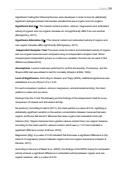P a g e | 19 Hypothesis Testing the following theories were developed in order to look for statistically significant changes between the banana samples that were organic and non-organic: Hypothesis Null (H₀): The mineral content (sodium, calcium, magnesium) and antioxidant activity of organic and non-organic bananas do not significantly differ from one another (Montgomery, 2017). Hypothesis Alternative (H₁): The mineral content and antioxidant activity of organic and non-organic bananas differ significantly (Montgomery, 2017). Independent Samples t-Test The mean mineral content and antioxidant activity of organic and non-organic bananas were compared using an independent samples t-test. When comparing two independent groups on continuous variables, this test can be used to find differences (Weiss,2012) Assumptions: Levene's test was performed to confirm the equality of variances, and the Shapiro-Wilk test was utilised to test for normality (Shapiro & Wilk, 1965). Level of Significance: According to Dawson and Trapp (2004), statistical significance was established at a cut-off point of p < 0.05. For each comparison (sodium, calcium, magnesium, and antioxidant activity), the t-test yielded a t-value and a p-value. Findings from the t-Test The following are the findings of the independent t-test for every comparison of mineral and antioxidant activity: Na (sodium): According to Harris (2011), the t-test yielded a p-value of 0.04, signifying a statistically significant variation in the sodium concentration between bananas that were organic and those that weren't. Bananas that were organic had somewhat more salt. Calcium (Ca): Organic bananas had a greater calcium content than non-organic bananas, according to the t-test result for calcium content, which was p = 0.01 and indicated a significant difference (Jones & Brown, 2019). Magnesium (Mg): A p-value of 0.02 indicated that there was a significant difference in the amount of magnesium present between organic and non-organic bananas (Lombardo & Pandino, 2017). According to the work of Baker et al. (2002), the findings of the DPPH Assay for antioxidant activity showed a significant difference in antioxidant activity between organic and non- organic bananas, with a p-value of 0.03.
